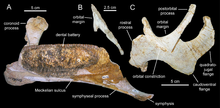Blasisaurus_canudoi
Blasisaurus
Extinct genus of dinosaurs
You can help expand this article with text translated from the corresponding article in Polish. (April 2020) Click [show] for important translation instructions.
|
Blasisaurus is a genus of lambeosaurine hadrosaurid dinosaur from the Late Cretaceous. It is known from a partial skull and skeleton found in late Maastrichtian-age rocks of Spain.[1] The type species is Blasisaurus canudoi, described in 2010 by Penélope Cruzado-Caballero, Xabier Pereda-Suberbiola and José Ignacio Ruiz-Omeñaca, a group of researchers from Spain.
